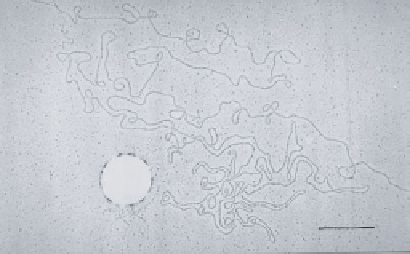Information Technology Reference
In-Depth Information
Figure 9.4
Electron micrograph of a small section of a micronuclear DNA molecule
from
Sterkiella nova
. Bar
=
1
µ
m. Courtesy of Dr. K. G. Murti.
diploid micronucleus divide without cell division to produce the appropriate
number of each (e.g., two macronuclei and two micronuclei, Figure 3f ).
The conversion of a micronuclear (germline) genome into a macronuclear
(somatic) genome involves many remarkable manipulations of micronuclear
DNA. Simultaneously, but not directly related to these DNA manipulations,
the originally silent micronuclear genes are switched to their genetically active
macronuclear form.
The complex processing of micronuclear DNA to create macronuclear DNA
can be appreciated by comparing the structure of the two DNAs. Each of the
approximately 100 micronuclear chromosome contains a single DNA molecule
that is, on average, more than 1 million basepairs (bp) in length (Figure 9.4).
The gene density is less than 5%, with gene-encoding regions, or genes,
widely distributed along this DNA separated by long spacers of nongene DNA
(Figure 9.5).
In sharp contrast, macronuclear DNA occurs in short molecules ranging in
length from about 200 bp to 20,000 bp (Figure 9.6). There are about 25,000
different molecules (different in their nucleotide sequences); each molecule
contains a single gene, or in a few cases 2 [14] or even 3 genes [11], yielding
an estimate of 27,000 genes. The macronucleus contains none of the spacer
Figure 9.5
A diagram of the arrangement of genes and spacers in a small section of
micronuclear DNA.


